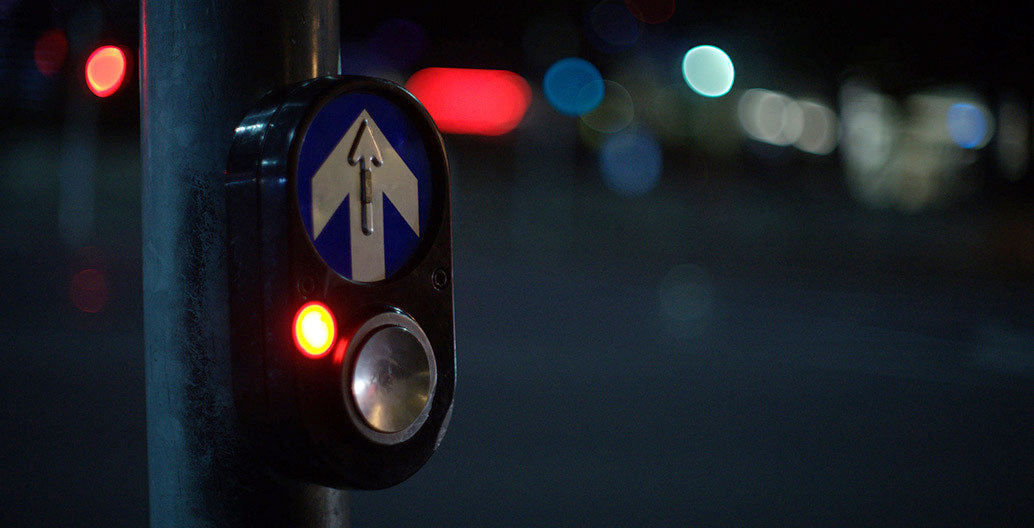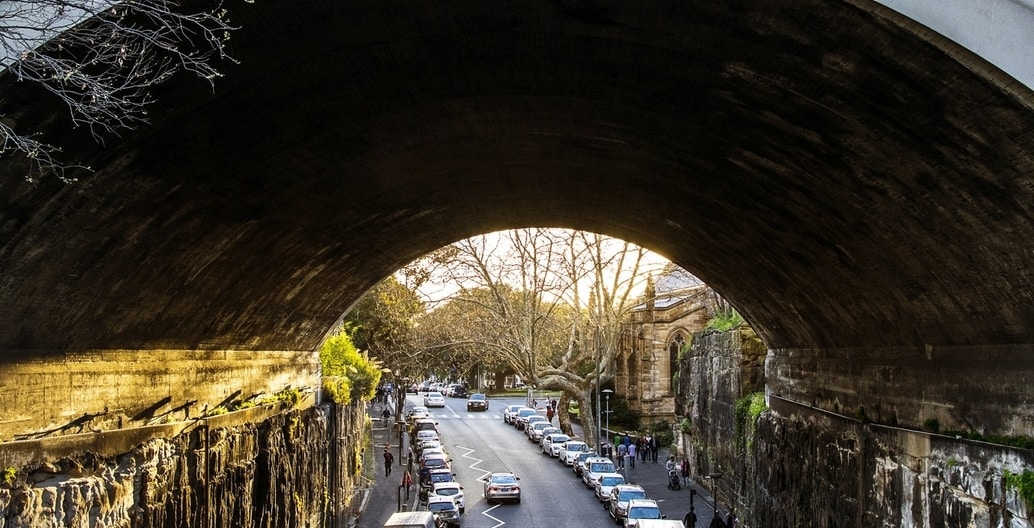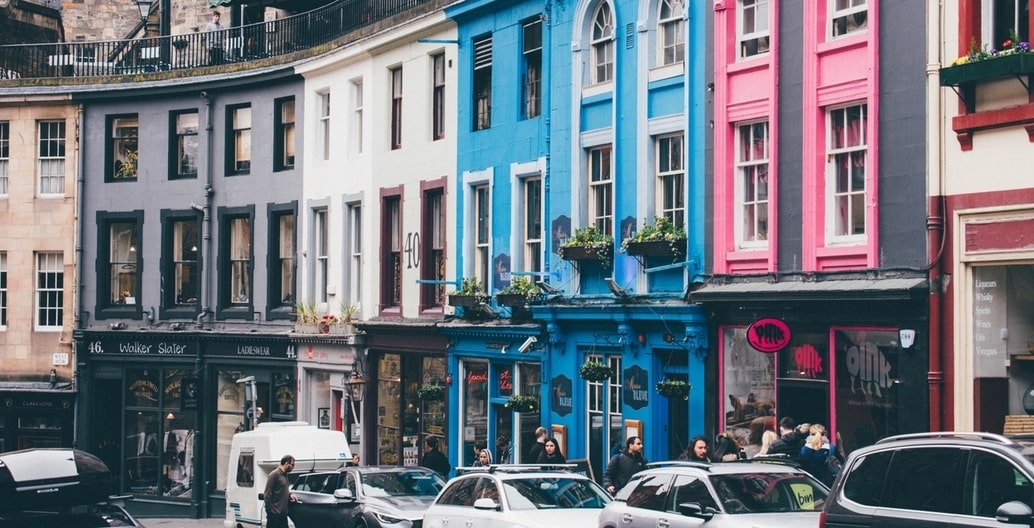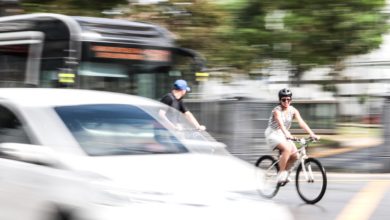
How can Sydney start a walking revolution to overthrow its killer cars?
Sydney’s addiction to cars is killing people, ruining quality of life and contributing to Australia’s significant greenhouse gas emissions. The rest of the world is waking up to the irrational and destructive privileging of cars over the safety and health of pedestrians. Time for a revolution.
Despite its aspirations to be a ‘world city’ and its abundant assets, Sydney persistently falls short of its potential. There are a number of reasons for this: a lack of infrastructure investment, ongoing disputes between local and state levels of government, a difficult colonial history that continues to play out, and a crazed property boom that has forced millions to leave their homes. Prominent amongst its problems, however, is the dominance of cars in the urban landscape and, conversely, the impoverished experience the city offers for pedestrians. Thankfully, however, there are solutions to these two interrelated issues.
The dominance of cars in New South Wales (NSW) kills hundreds of people directly and likely thousands of people indirectly a year. Cars kill directly by hitting things like other cars, cyclists and people, and indirectly through air pollution. There is nothing inevitable about these deaths. It’s a choice we make. Last year 362 people died on NSW roads, historically low, but pedestrian deaths increased dramatically last year. Fatalities from air pollution are harder to measure, but in 2016 The Australian Institute of Health and Welfare estimated total deaths from air pollution nationally to be 3000; almost three times higher than the national road toll. This is more than another review, which noted that while 1224 people died from vehicle accidents, about 1715 probably died as a result of vehicle pollution. In what other industry or workplace would we accept such a high impact?
The dominance of traffic also plainly makes large parts of the city horrible to be in. Just look at the impact of the six lanes of traffic on Parramatta road, the seven lanes on Victoria Road, or seven lanes of traffic at the top of George Street running past the biggest bus station in the city and the central train station. Seven lanes of traffic in the heart of Sydney. It’s dangerous and chokes all urban joy in this part of the city. The state response to the safety issues caused by mixing 50km/hr metal boxes with human bodies is to separate them with fences and concrete barriers, and issue fines for ‘j-walking’. These responses may prevent some injuries, but they make the city even worse to walk around and do nothing to address air pollution.

Sydney has historically been a walking city. Gadigal people have been walking along its ridgelines for thousands of years. They created the pathways that major roads still follow. In the hundred or so years after European arrival, Sydney was created as a dense urban environment perfect for walking. It wasn’t until World War I that public transport really changed the character of the city, and after WWII that the car started to dominate planning. Pedestrian-focused areas can still be experienced in suburbs like the Rocks and Surry Hills. There are many books that tell stories of experiencing Sydney through walking, perhaps most beautifully by Vanessa Berry who documents the fleeting, marginal parts of Sydney in Mirror Sydney.
The detrimental urban impacts of cars are recognised globally
The detrimental urban impacts of cars have long been understood by designers and scholars of cities. Jane Jacobs, Jan Gehl, William H Whyte have all made convincing arguments that designing cities for people to walk around is the most socially, environmentally and economically effective way to plan. Gehl’s study of central Sydney in 2007 discovered that the focus on moving cars means Sydney has some of the longest pedestrian waiting times at lights in the world. No wonder people get hit trying to cross.
The International Panel on Climate Change concluded in October last year that we, collectively, have about 12 years to halve emissions if we’re to avoid catastrophic climate change. Transport is a major emitter of carbon; to achieve this reduction, a transformational shift in transport planning is required. Fortunately, 12 years is just long enough to plan and implement major infrastructure and behavioural change. Cities such as Vancouver are leading the way. It has promised that by 2030 two thirds of all trips within the city will be by either passive transport (walking and cycling) or public transport. The remaining third will be half electric and half petrol cars. What would Sydney look like if it embraced the same, now necessary, goals?
Many cities around the world have shifted their focus and research is starting to demonstrate the many benefits of walking. For example, an experiment in shutting down roads in the Madrid’s city centre resulted in a 9.5% increase in retail takings on its main shopping street, and a dramatic increase in the city’s air quality. Oslo is close to banning cars from its entire central city and no longer provides on-street parking. London and New York both have congestion charges. Barcelona is creating Superblocks in which only local traffic can slowly move into pedestrian zones. Even much smaller Auckland is leading Sydney, with the council recently voting to support long term planning for a largely car-free central city.
In Australia, meanwhile, Melbourne recently voted on a 10 year plan to make all car speeds in the central city 30km/h, to continue to remove on-street parking, and to pedestrianise a series of inner city streets. Since 2016, Adelaide has had a policy of prioritising pedestrian movement, taking advantage of opportunities to value-add pedestrian friendly elements during routine maintenance programs.
Many designers and others see a technological fix to these problems coming by way of electric and self-driving cars, but this misunderstands the tripartite nature of the car dominance problem. Electric vehicles solve much of the pollution problem, but none of the deaths by impact or the erosion of public space in cities. Future self-driving cars are similar and risk being even worse for pedestrian conviviality. Neither of these technologies mitigate against all three problems in a way that walking, cycling, and public transport do, and neither of them are yet widely applicable.The solution to these problems is to create spaces and networks and infrastructures for the slow, steady, reliable and human scale experience of walking through the city – not a new kind of car.
What can be done to lead this transformation? Here are six ideas for change.
Six ideas to start the walking revolution
First, make it easy to temporarily close streets. This could begin with trials and pop-up community activation. My thesis research suggests that temporary community-led experiments have a powerful role to play in shifting people’s sense of what is possible and practical. Reform local council procedures enabling local street closure for neighbourhood events, street parties and kids activities. Make this a simple one-page process, or easy-to-use website application ensuring basic safety procedures and communication. The weather in Sydney is perfect for street BBQs, crickets games and picnics. The regular closure of streets on both small and large scales is a great way to show people how the city can be different. For example, Edinburgh has recently joined the Open Streets movement and will close many inner city streets once a month as part of an extensive trial.

Second, start to close smaller local streets or create shared slow lanes with access only for local residents. Streets with few cars could accommodate the passage of slow traffic when needed by residents, while opening up new spaces for permanent gardens, planting, children’s playgrounds and more community space.
Third, put human life before time savings. Thirty km/h should become the default speed for local residential streets, with identified traffic corridors and networks going up to 40km/h, 50km/h or even 60km/h. The World Health Organisation has identified likely effects of pedestrian impacts with cars at various speeds. At 30km/h there is a 90% chance of survival, but pedestrians and cyclists have less than 50% chance of surviving an impact at 45km/h.
Fourth, start designing cities for children. By making it safe and fun for them to move around the city, we also make it safe and fun for adults and families. Kids and cars don’t mix, so rather than making discrete walled areas for children, let us make big pathways, parks and regions safe for them. This is a growing area of interest and research has public health benefits for children and adults alike.
Fifth, create a process that begins to charge drivers the real costs of alienating public space for street or public off-street parking. This is valuable public land that is gifted to drivers. Use this land for public activities, environmental projects, flood mitigation and other mobility modes including bikeways. Australian cities have limited space and yet thousands of square kilometres of public space is gifted for car storage.
Lastly, we could expand on research by scholars such as Professor Jakelyn Troy, who have identified how contemporary Sydney streets are built over and follow the same routes as older Aboriginal pathways. Why not let the origins of these roads be revealed in the city, creating a series of walkways along urban ridges into and across the suburbs? Trees and physical shelters could be used to keep people cool during the increasingly hot days. Commuters may happily walk up to an hour into work if the environment was cool and well designed, relieving increasing pressure on roads and public transport alike and saving billions in health costs. It would also raise consciousness of walking routes that have been used for tens of thousands of years, leading not just to a shift in transport mode but also the city’s sense of identity. The identification and development of these walking highways could be led by Aboriginal communities and designers, supporting local and Aboriginal businesses and ventures.
The revolution can be staged but urgently needs to start
Deployed separately or in only particular places these moves might act to gentrify certain areas, raise house prices and perhaps even displace existing communities. It’s a real risk, but there are many benefits to this urgently needed transition and there are ways to mitigate the risk. By doing a series of initial interventions en masse and across the city, the risk of gentrification is minimised, maximising amenity throughout the city rather than discrete parts of it.
Many of these moves do not need to be expensive. Simply restricting cars and public realm car parking is a first step that can be almost immediately implemented, even if only at certain times. Then, as normal maintenance and renewal programmes move through the city, public spaces can be adapted to new uses with installation of more permanent elements. Indeed, this often makes more sense than expensive and high-visibility infrastructural makeover projects that require sudden and radically different behaviours.
The revolution is not an outright rejection of cars. Many citizens depend on them to provide timely transport, and will continue to do so. Rather, this is a call to place cars a little lower down the hierarchy of needs. When other modes of transport are preferred, vehicular traffic flow is actually improved, making it a better city for those that do need to drive. It is perhaps when people can again walk freely and comfortably around the city, along its ancient ridgelines, and through its vibrant suburbs, that we might learn to love a pedestrian experience of Sydney’s wonderful urbanity again, as it deserves.
–
Dr Barnaby Bennett is the publisher and co-editor at Freerange Press. He is an award-winning designer, writer, and researcher. His recently published PhD thesis examines the relationship between temporary projects, infrastructure and politics in post-quake Christchurch.


